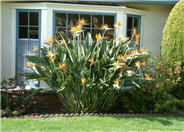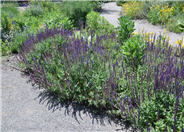
Common name:Bird of Paradise
Botanical name:Strelitzia reginae
This shrub will grow to 6' tall and has large, grey-green fronds with orange, blue, white, or multi-colored flowers that bloom throughout the year.

Common name:Orange or Brown Sedge
Botanical name:Carex testacea
The testacea variety is an evergreen perennial that reaches 2' tall bearing very narrow, coppery brown leaves splitting to hair-like threads at their tips, and continuing to grow to 4-8' in length. This plant should be grown in sun with little or no summer watering. During winter, foliage turns orange. If this grass is planted in shade, foliage stays green. Flowers are insignificant. Orange Sedge looks great in containers or spilling over near walkways or into water features.

Common name:Garden Pansy
Botanical name:Viola X wittrockiana
This annual will grow 6"-10" tall and 9"-12" wide. It has shiny green leaves with flowers that come in a wide variety of colors and are in constant bloom from fall to spring.

Common name:Annual Lobelia
Botanical name:Lobelia erinus
This short groundcover has small green leaves with blue or red flowers that bloom in the summer and fall.

Common name:Buchanan Sage, Buchanan's Fuchsia S
Botanical name:Salvia buchananii
Salvia buchananii is a beautiful perennial that grows up to 1 to 2' tall but is more spreading than upright. It does not like frost and will act more like an annual in colder climates. Fuzzy, magenta flowers, 1" long, bloom in the summer. It attracts butterflies and hummingbirds. Leaves are glossy green. This plant tends to be brittle so it's best to plant in areas with low traffic.

Common name:Saltillo Evening Primrose
Botanical name:Oenothera stubbei
This plant is a perrenial with a dense mat of green foliage and blooms yellow in the summer. It is drought tolerant and attracks hummingbirds. - Cornflower Farms
If you mulch heavily as recommended in the compost and mulch fact sheets you should not need traditional fertilization. Sustainable landscapes fertilize themselves as soil organisms break down and recycle the dropped leaves into nutrients.
Click in the green box for more information
Designer:
Photographer: GardenSoft
Physical weed control, including mulching, or hand removal protects the watershed from harmful chemicals.
Remove irrigation water and fertilizer from areas where you don't want weeds to grow.